旅行的艺术:艺术 Ⅶ 令人眼界大开的艺术-4
4
4
在客房里有一本大部头的关于凡·高的书。到这里的第一个晚上我无法入睡,因此读了其中的几章,我贪婪地阅读着,直到粉色的黎明映现在窗户的角落,才让书页翻开着而沉沉睡去。
There was a large book on him in the guest bedroom and, because I was unable to sleep on my first night, I read several chapters, eventually falling asleep with the volume open on my lap as a trace of dawn-red appeared in the corner of the window.
我醒得很晚,醒来时发现主人们已经前往圣雷米了,他们留下一张字条告诉我他们会在午饭时间回来。早餐放在台阶上的一张金属桌上,我以极快的速度,接连吃了3个巧克力面包。我感到很不好意思,吃的时候一直在留意着管家,担心她会把我狼吞虎咽的情形告诉给她的主人。
I awoke late and found that my hosts had gone to Saint-Rémy, leaving a note to say that they would be back at lunchtime. Breakfast was laid out on a metal table on the terrace and I ate three pains au chocolat in guilty, rapid succession, while keeping one eye out for a housekeeper, whom I feared might put an unflattering spin on my gourmandise to her employers.
这天天气晴朗,干燥而寒冷的西北风吹乱了临近田地里的麦穗。昨天我也坐在这个位置,可是直到现在我才注意到在花园的尽头有两棵高大的柏树——这一发现与晚上我所读到的凡·高关于柏树的描述不无关系。从1888年到1889年,凡·高创作了一系列关于柏树的素描。“它们一直占据着我的思想,”他对他的弟弟说,“令我惊讶的是,它们仍没有像我所看到的那样被描绘过。柏树的线条和比例就像埃及的方尖石塔(金字塔)一样美。它的绿色有一种如此独特的气质。这种绿是在一片充满阳光的风景上泼洒上的黑色,像是最有趣,也最难弹奏正确的黑色音符。”
It was a clear day with a mistral blowing, which ruffled the heads of the wheat in an adjacent field. I had sat in this spot the day before, but only now did I notice that there were two large cypresses growing at the end of the garden-a discovery that was not unconnected to the chapter I had read in the night on Van Gogh's treatment of them. He had sketched a series of cypresses in 1888 and 1889. 'They are constantly occupying my thoughts,' he told his brother, 'it astonishes me that they have not yet been done as I see them. The cypress is as beautiful of line and proportion as an Egyptian obelisk. And the green has a quality of such distinction. It is a splash of black in a sunny landscape, but it is one of the most interesting black notes, and the most difficult to hit off exactly.'
关于柏树,有哪些是凡·高注意到了,却为其他画家所忽略了的呢?有一部分,是柏树在风中摆动的一些姿态。由于凡·高的作品,特别是1889年画的《柏树》和《麦田和柏树》这两幅画,我走到花园尽头,仔细研究那两棵柏树在北风中特别的姿态。
What did Van Gogh notice about cypresses that others had not? In part, the way they move in the wind. I walked to the end of the garden and there studied, thanks to certain works (Cypresses and Wheat Field and Cypresses of 1889 in particular) their distinctive behaviour in the mistral.
柏树独特的摆动背后有着建筑学上的考量。与松树不同,松树的枝叶是从它的顶部向下缓慢地下垂,柏树的枝叶则是从地面往上蹿升。树干异常的短,而最顶部的1/3处全是由枝条组成的。在风中,橡树的枝条摇摆不定而主干屹立不动,但是柏树则整棵树都摇来摇去,而且由于柏树的枝叶是沿着树干周围的许多点生长出来的,柏树在风中就好像是绕着不同的轴弯曲。从远处看,由于摆动的幅度不一致,柏树看上去像是同时被几股来自不同方向的风吹得摇摆不定。它那类似圆锥的外形(柏树的直径很少有超过一米的),使它呈现出一种类似火焰的形态,似乎在风中紧张不安地摇曳。这一切是凡·高注意到并希望其他人看到的。
There are architectural reasons behind this movement. Unlike pine branches, which descend gently downwards from the top of their tree, the fronds of the cypress thrust upwards from the ground. The cypress's trunk is, moreover, unusually short, with the top third of the tree being made up wholly of branches. Whereas an oak will shake its branches in the wind while its trunk remains immobile, the cypress will bend and, furthermore, because of the way the fronds grow from a number of points along the circumference of the trunk, it will seem to bend along different axes. From a distance, the lack of synchronicity in its movements makes it look as though the cypress were being shifted by several gusts of wind blowing from different angles. With its cone-like shape (cypresses rarely exceed a metre in diameter), the tree takes on the appearance of a flame flickering nervously in the wind. All this Van Gogh noticed and would make others see.
凡·高在普罗旺斯待了几年以后,奥斯卡·王尔德评论说,在惠斯勒 [14] 画出伦敦的雾之前,伦敦并没有雾。在凡·高画出普罗旺斯的柏树以前,普罗旺斯的柏树一定也少得多。
A few years after Van Gogh's stay in Provence, Oscar Wilde remarked that there had been no fog in London before Whistler painted it. There had surely been fewer cypresses in Provence before Van Gogh painted them.
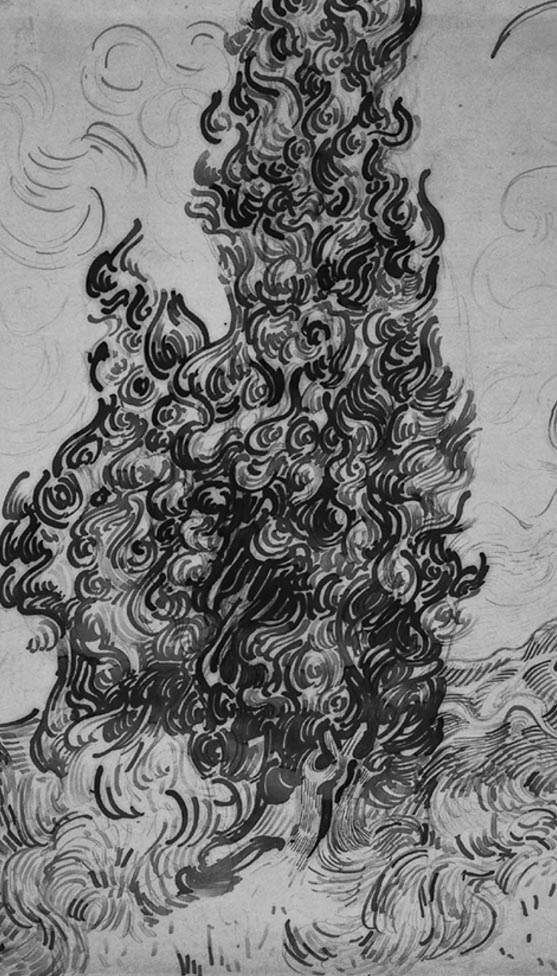
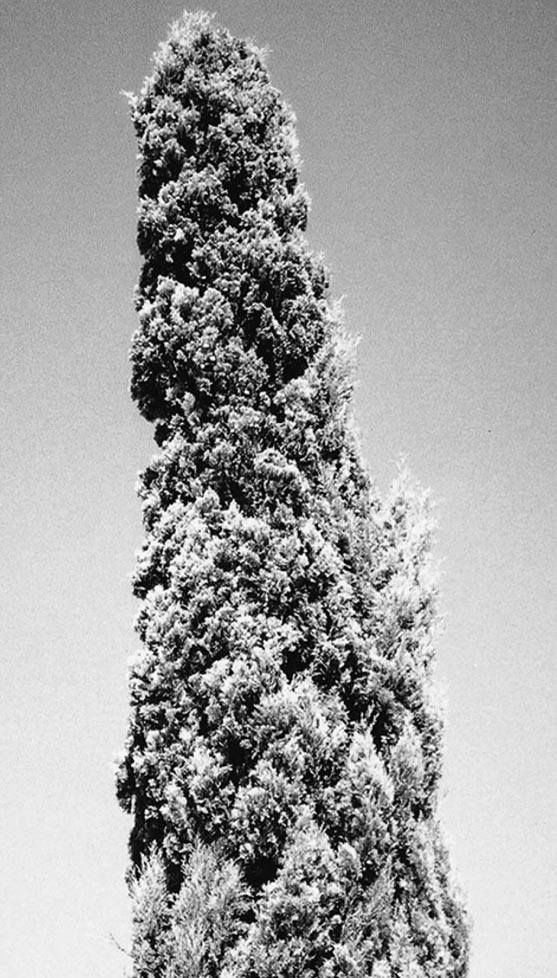
凡·高:《柏树》,1889年
橄榄树在过去也很少引人注意。昨天,我还对一株矮小的橄榄不屑一顾,但是凡·高1889年的作品《橄榄树、黄色的天空和太阳》及《橄榄林:橘红的天空》使橄榄树成为了主角,展现了它们的树干和树叶的形态。我现在才发现我原来没注意到这种种的棱角:一棵棵橄榄树就好像三叉戟,被一股巨大的力量投掷进土壤中。橄榄树的枝叶看起来也力道十足,仿佛它们是弯曲着的臂膀,随时准备出击。很多树的叶子看起来软趴趴的,像是摆久了的莴苣叶子,但橄榄树的叶片结实,银亮,看起来神采奕奕、精力旺盛。
Olive trees must also have been less noticeable. I had the previous day dismissed one example as a squat bush-like thing but, in Olive Trees with Yellow Sky and Sun and Olive Grove: Orange Sky of 1889, Van Gogh brought out-that is, foregrounded-the olives' trunks and leaves. I now noted an angularity which I had earlier missed: the trees resemble tridents that have been flung from a great height into the soil. There is a ferocity to the olive trees' branches too, as if they were flexed arms ready to hit out. And whereas the leaves of many other trees make one think of limp lettuce emptied over racks of naked branches, the taut silvery olive leaves give an impression of alertness and contained energy.
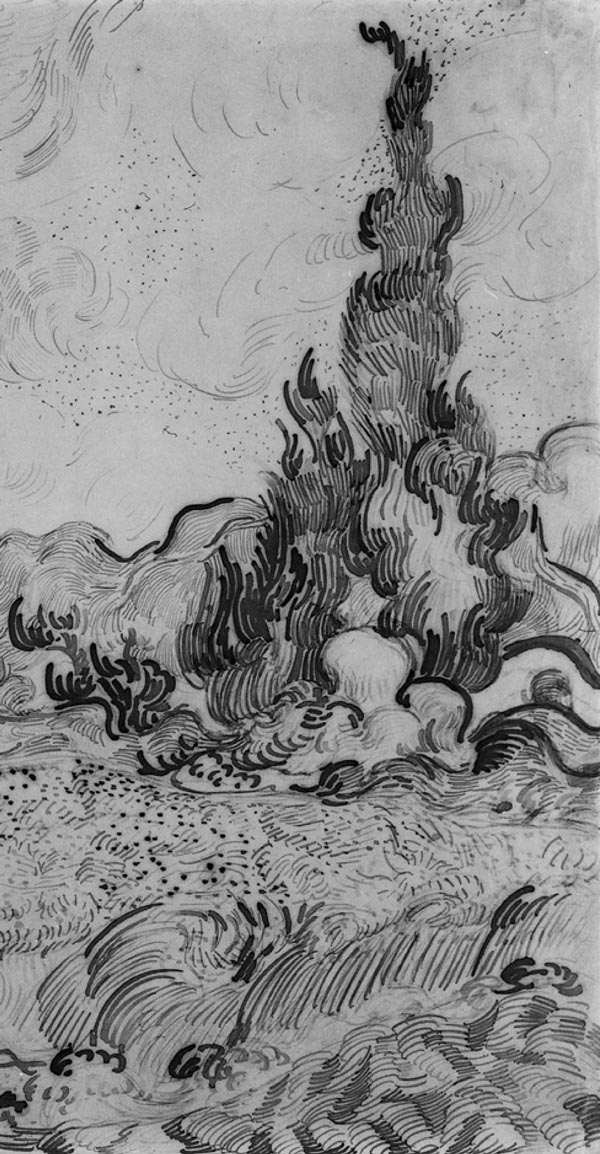
凡·高:《麦田与柏树》,1889年
跟随着凡·高,我也开始注意到普罗旺斯在色彩上一些不同寻常的地方。这和这里的气候有关。从阿尔卑斯山顺着罗讷山谷吹来的干燥寒冷的北风,有规律地吹净天空中的云朵和水气,在天空中留下一片纯净饱满而没有一丝白色的蓝。同时,地中海型气候和高水位以及良好的灌溉,使植物格外地繁茂。这里没有缺水之虞,植物可以自由自在地生长,尽量利用南方的光和热。并且,很幸运的是,空气中没有湿气,因此,不像热带的气候多雾潮湿,树木,花朵和植物的颜色因而格外鲜明。无云的天空、干燥的空气和水分充足且鲜艳的植物,这些因素相结合使普罗旺斯充满明艳、生动的对比色。
After Van Gogh, I began to notice that there was something unusual about the colours of Provence as well. There are climatic reasons for this. The mistral, blowing along the Rhône valley from the Alps, regularly clears the sky of clouds and moisture, leaving it a pure rich blue without a trace of white. At the same time, a high water table and good irrigation promote a plant life of singular lushness for a Mediterranean climate. With no water shortages to restrict its growth, the vegetation draws full benefit from the great advantages of the south: light and heat. And fortuitously, because there is no moisture in the air, there is in Provence, unlike in the tropics, no mistiness to dampen and meld the colours of the trees, flowers and plants. The combination of a cloudless sky, dry air, water and rich vegetation leaves the region dominated by vivid primary, contrasting colours.
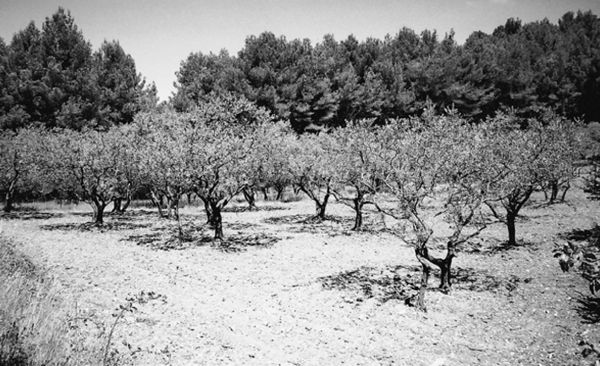
凡·高之前的画家常常忽视这些相互形成对比的色彩,而只是将它们画作补充的色彩,就像克劳德和普桑传授的技法。比如康斯坦丁和毕道尔描绘的普罗旺斯,完全在柔和的蓝色与棕色中细微地变化。凡·高因大家忽略了普罗旺斯的自然色彩而忿忿不平:“大多数的画家对色彩的研究不深……没有看到南方的黄色、橙色、硫磺色,并且如果有一个画家用眼看到了他们没有看到的色彩,他们就说这个画家疯了。”因此,凡·高摒弃了传统的明暗对比法的技巧,大胆用原色在画布上挥洒,将颜色的对比表现得淋漓尽致:红与绿,黄与紫,蓝与橙。“这里的色彩非常精美,”他告诉他的妹妹,“叶子新鲜时是一种丰润的绿,是那种我们在北方很少看到的绿。当它枯萎时,蒙上了灰尘,它仍没有失去它的美,因为那个时候整片景色已经染上了各种色调的金色,绿色的金,黄色的金,粉色的金……这种金色色调与蓝色相结合,有水的宝蓝,勿忘我的靛蓝,特别是亮丽明艳的钴蓝。”
Painters before Van Gogh had tended to ignore these contrasts and to paint only in complementary colours, as Claude and Poussin had taught them to do. Constantin and Bidauld, for example, had depicted Provence entirely in subtle gradations of soft blue and brown. Van Gogh was incensed by this neglect of the landscape's natural colour scheme: 'The majority of [painters], because they aren't colourists … do not see yellow, orange or sulphur in the South, and they call a painter mad if he sees with eyes other than theirs.' So he abandoned their chiaroscuro technique and soaked his canvases in primary colours, always arranging them in such a way that their contrast would be maximized: red with green, yellow with purple, blue with orange. 'The colour is exquisite here,' he wrote to his sister. 'When the green leaves are fresh, it is a rich green, the likes of which we seldom see in the North. Even when it gets scorched and dusty, the landscape does not lose its beauty, for then it gets tones of gold of various tints: green-gold, yellow-gold, pink-gold … And this combined with the blue-from the deepest royal blue of the water to the blue of the forget-me-nots; a cobalt, particularly clear bright blue.'
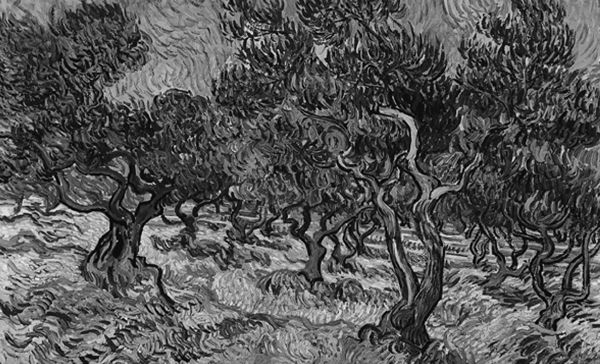
我的眼开始习惯于从(凡·高)帆布画上的主色去看这个世界。目光所及的每一个地方,我都能够看到最主要的色彩之间的对比。在房子旁边有一片紫色的薰衣草与黄色的麦田毗邻。房子的屋顶是橙色的,与纯净蓝色的天空相映。绿色的草地上点缀着红色的罂粟花,草地的四周则是夹竹桃。
My own eyes grew attuned to see around me the colours that had dominated Van Gogh's canvases. Everywhere I looked, I could see primary colours in contrast. Beside the house was a violet-coloured field of lavender next to a yellow field of wheat. The roofs of the buildings were orange against a pure blue sky. Green meadows were dotted with red poppies and bordered by oleanders.
这里,不是只有白天才色彩缤纷。凡·高也为夜空上了色。以前,普罗旺斯的画家所描绘的夜空总是一片黑上点缀着些许小白点。然而,当我们在一个明朗的夜晚,远离亮着灯的房屋和街灯,坐在普罗旺斯的天空下,我们会注意到天空实际上包含着丰富的色彩:在星星之间,似乎有一种深蓝、紫色、或是暗绿,而星星本身却呈现出一种苍白的黄色、橙色或绿色,放射出的光环远远超过了它们自己狭窄的周边。就像凡·高向他妹妹解释的:“夜晚甚至比白天更加色彩斑斓……只有你注意着它,你才会看到有些星星是淡黄色的,其他的星星有一种粉红色的光芒,或者泛着绿色、蓝色,和勿忘我的光辉。不用说,只在蓝黑背景上放置白色的小点,显然是不够的。”
It was not only the day that abounded in colours. Van Gogh brought out the colours of the night as well. Previous Provençal painters had depicted the night sky as groupings of little white dots on a dark background. However, when we sit under the Provençal sky on a clear night far from the glow of houses and street-lamps, we notice that the sky in fact contains a profusion of colours: between the stars, it seems a deep blue, violet or very dark green, whereas the stars themselves appear a pale yellow, orange or green, diffusing rings of light far beyond their own narrow circumference. As Van Gogh explained to his sister: 'The night is even more richly coloured than the day … If only you pay attention to it you will see that certain stars are citronyellow, others have a pink glow, or a green, blue and forget-me-not brilliance. And without expatiating on this theme it should be clear that putting little white dots on a blue-black surface is not enough.'
- 频道推荐
- |
- 全站推荐
- 推荐下载
- 网站推荐


















